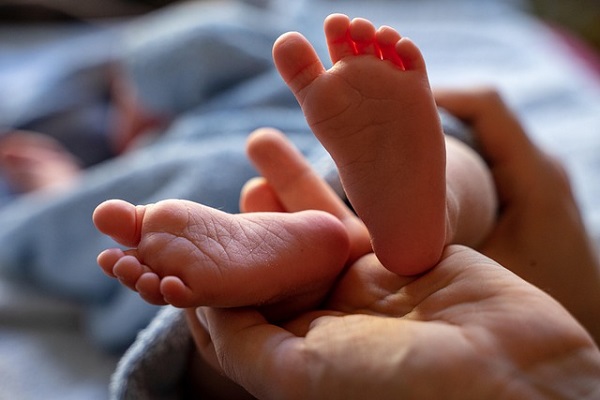 Credit: Pixabay
Credit: Pixabay
It is no secret that Europe's population is ageing and birth rates are falling - trends often painted as a looming crisis.
Politicians warn of shrinking workforces, overstretched pensions and the perils of demographic decline. While some aspects of these shifts are genuinely worrying (such as fertility struggles and financial barriers), they also reflect something worth celebrating: women (and young people) having more choices than ever. The challenge now is not to reverse the decline at all costs, but to adapt to the social and economic realities that follow.
And let's be clear: the reality is more nuanced than the idea that people simply no longer want children. Some are happily child-free by choice, others would like one or more children but cannot for various reasons. Whatever the reason, we must avoid placing the "blame" for falling birth rates - so often framed as a negative - on women.
Statistics for Luxembourg, Europe & Beyond
Eurostat data show that fertility rates across the European Union (EU) have been falling steadily since the mid-1960s. In 2023, the EU recorded 3.67 million live births - down from 3.88 million in 2022. The total fertility rate fell to a record low of 1.38 live births per woman (1.46 in 2022). Not a single EU country reached the replacement level of 2.1. The highest rates were in Bulgaria (1.81), France (1.66) and Hungary (1.55), while the lowest were in Malta (1.06), Spain (1.12) and Lithuania (1.18).
France - traditionally a fertility leader in Europe - saw more deaths than births in a twelve-month period for the first time since 1945, with 800 more deaths than births between May 2023 and May 2024 (INSEE). Falling birth rates prompted President Emmanuel Macron to call for a "demographic rearmament" through new reforms, although critics warn some policies risk placing the burden disproportionally on women.
In general, women across Europe are also having children later in life. In 2023, the average age of first-time mothers was 29.8 years, ranging from 26.9 in Bulgaria to 31.8 in Italy. Births to women aged 30+ are increasingly common, marking a clear shift in the timing of motherhood.
In Luxembourg, the average age of first-time mothers in 2023 was 31.2 - up from 30.9 in 2020, 29.5 in 2010 and 28.1 in 2000 (STATEC). The largest share of mothers were aged 30-34, followed by 35-39 and then 25-29. By contrast, in 1980 and 1990, the 25-29 age group dominated.
Luxembourg also has a below-average fertility rate: 1.25 in both 2023 and 2024. The rate is higher among non-Luxembourgish women (1.41) than Luxembourgish women (1.12). In 1980, the overall rate was 1.50 (1.37 for Luxembourgish women; 1.83 for foreign women).
In 2024, there were 6,459 live births - up 2.2% from 2023 but still below 2021-2022 levels. Deaths remained stable at 4,471, leaving a positive natural balance of 1,988. However, most of Luxembourg's population growth comes from immigration: net migration of +9,281 accounted for the bulk of the 1.5% growth between 2023 and 2024. The population has risen from 364,602 in 1981 to 681,973 as of 1 January 2025, although growth slowed in 2024 due to low fertility and a 4.6% drop in immigration. The UN projects that Luxembourg's population will keep growing beyond 2054, largely due to net migration increasing the number of women of reproductive age and thus potential births.
Like much of Europe, Luxembourg's population is ageing. Life expectancy stands at 81 years for men and 85 for women. In 1981, the largest share of the population was aged 20-39; by 2024, it was aged 40-64. Foreign residents tend to be younger, often arriving in working age for professional opportunities. The country's 2024 age pyramid has a narrow base, a broad middle and a tapering top - with a relatively high proportion of residents aged 80+. Low fertility, professional migration and rising life expectancy all contribute to this shape.
Fertility is also falling beyond Europe. UN data shows the average number of births per woman dropped from around five in the 1950s-60s to just above two in 2024. Over half of the world's most populous countries are now below replacement level. In some countries, including China, South Korea and Singapore, the rate has fallen below one. The UN now expects global fertility to hit replacement level by 2050 - 23 years earlier than predicted a decade ago - and to fall further to about 1.8 by 2100.
Only parts of sub-Saharan Africa and a few other countries still have fertility rates above four, and even those are declining. When I visited Niger in 2022, it still held the world's highest rate - but this has dropped from 7.79 in 1994 to 5.94 in 2024, with projections of 3.03 by 2054. Chad now tops the list at 6.03 (expected to drop to 3.62 by 2054).
The UN argues that gender equality and women's empowerment can address both high and low fertility: in high-fertility contexts, this means tackling child marriage, expanding reproductive healthcare and improving education; in low-fertility contexts, it means closing gender gaps in domestic labour and childcare and ensuring family policies support people to have children - as many or few as they want - if and when they choose.
Why Birth Rates are Falling
There are many reasons why people are having fewer (or no) children - and later in life. A growing acceptance of varied life paths reflects increased personal freedom. For some, remaining child-free is a deliberate and positive choice. "Childfree by choice" individuals and "DINK" (double income, no kids) couples may prioritise their careers, travel, pets or volunteering for a cause, among other pursuits. For others - particularly younger generations - the choice may be driven by environmental concerns and awareness of how overpopulation and overconsumption strain resources.
A 2024 INED study found that 12.2% of French people did not want children - more than twice the number from 2005. Among 18- to 29-year-olds, 15% of women and 13.3% of men said they do not wish to be parents. Reasons range from lack of desire to the physical toll of pregnancy, to wanting independence, to rejecting traditional parenthood models. The still unequal distribution of domestic labour plays a role - in Luxembourg, according to STATEC, women spent five and a half hours a day with their children in 2014 (most recent figures found) - two more than men - mostly on domestic tasks and meal preparation. While the picture may have (hopefully) shifted in the intervening decade, it remains widely recognised that women do the bulk of unpaid domestic work.
Even among those who want children, desired family size is shrinking - often for economic reasons. Among French women under 30 (INED study), the average desired number of children fell from 2.5 in 2005 to 1.9 in 2024. The reasons are familiar: high cost of living, job insecurity and housing instability. Moreover, a recent UN Population Fund study across fourteen countries found that one in five people could not have the number of children they wanted; more than half cited economic issues as a major obstacle.
Luxembourg, for all its generous allowances and parental leave, is no exception. Family benefits are high by EU standards - €3,789 annually per person in 2022 - but are set against high living costs, especially housing. For many households, two salaries are essential just to cover rent or mortgage payments, and childcare can be costly and hard to secure (and not every woman wants to be a stay-at-home mother - it is all about personal choice). These economic realities may push some into smaller families or no children at all.
Another factor is infertility, which affects an estimated one in six people worldwide. Causes vary - some preventable, others not. The World Health Organization (WHO) stresses that infertility can undermine the right for individuals and couples to decide the number, timing and spacing of children. It calls for improved availability, access and quality of infertility interventions, such as IVF, and ensuring access without discrimination. Progress has been made in Luxembourg for same-sex couples, for example, but barriers remain: lengthy legal processes (adoption) and high costs mean the "choice" to have children is still not equally available to all.
Policies & Challenges Ahead
Fertility is shaped by multiple factors: government policy, access to reproductive health education and contraception, economic conditions, and cultural or religious norms. Pronatalist policies - from Macron's "demographic rearmament" to Donald Trump's proposed $1,000 baby bonus in the US - often make headlines but rarely shift long-term fertility trends.
China's one-child policy (1979-2015) illustrates the unintended consequences of attempts to control birth rates. The country's current below-replacement fertility rate has been attributed to both this policy's legacy and wider socioeconomic changes and challenges.
The OECD warns that population decline from low fertility and an ageing population could put significant social and economic pressures on governments, notably regarding pension (a hot topic in Luxembourg) and healthcare spending. "Facilitating parenthood decisions requires comprehensive and reliable support to families," said Stefano Scarpetta, Director of the OECD's Employment, Labour and Social Affairs Directorate. "This includes affordable housing, family policies that help reconcile work and family life, and coherence with other public policies that promote access to quality jobs and career progression of women."
Indeed, for many women, the question is not whether to work (outside the home) but how to combine work with family life. Access to flexible jobs, affordable childcare and supportive workplace policies can make a decisive difference; without them, women may delay or forego parenthood rather than (potentially) sacrifice their careers. Facilitating women’s return to the workforce is not only about equality but also economic necessity: with shrinking working-age populations, societies cannot afford to sideline half their talent pool.
The real debate is no longer whether fertility rates will bounce back - most demographers agree they will not - but about how societies adapt to ageing populations. The OECD urges countries to rethink strategies for a new "low-fertility future", including proactive migration and integration policies and facilitating access to employment for under-represented groups; boosting productivity would also help offset a shrinking workforce.
For Luxembourg, as for Europe, the challenge is to sustain economic vitality and social cohesion without pressuring people into having children they do not want or cannot afford - while ensuring the right conditions for those who do want to be parents. Tackling housing costs, for example, could both attract more qualified migrant professionals and enable residents who want children to have them.
On the other hand, Luxembourg’s projected continued population growth through net migration brings its own challenges, adding pressure on housing, infrastructure and social funding (notably pensions and healthcare) - issues that mirror those faced by many Western countries.
Concluding Remarks
An older, smaller population certainly poses challenges, but it also reflects real progress in healthcare, quality of life, personal freedom, gender equality, education and reproductive choice. Later pregnancies often mean fewer teenage pregnancies, and longer lives are a success story in themselves. The goal should not be to coerce the numbers back up, but to create a society where everyone can build the life they want, whether that includes having children or not.
If that means adapting to a different demographic shape, so be it. The future will not be saved by baby bonuses or slogans about "rearmament"; it will be shaped by policies that respect choice and address inequality. And for women - still too often carrying this burden - or young people who are confident in their decision to remain child-free: stop telling them they will change their minds. Allow people the choice: sterilisation if they want it, safe access to abortion on the one hand and infertility treatment on the other, to support everyone in these life-defining decisions - without the stigma.









